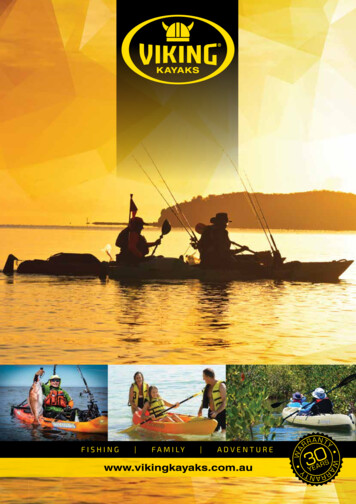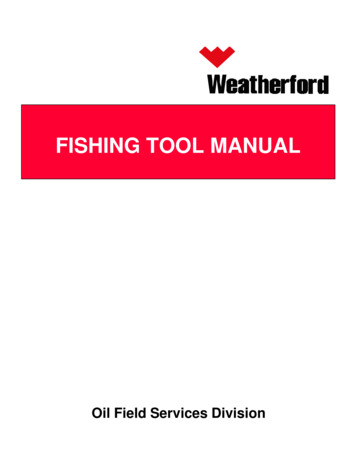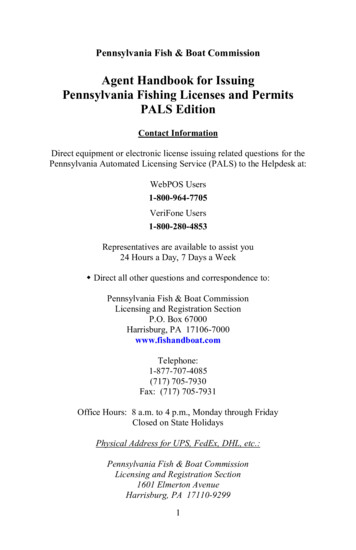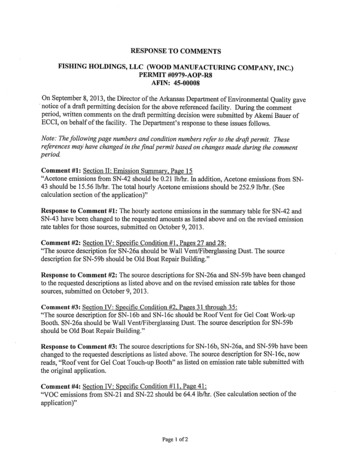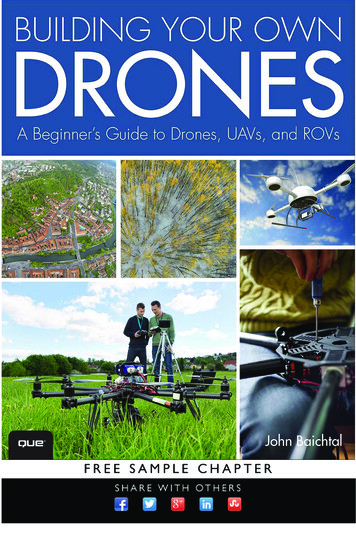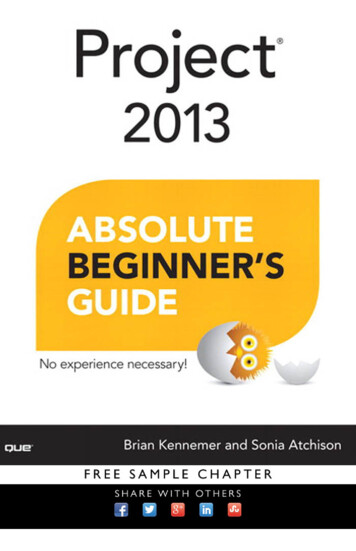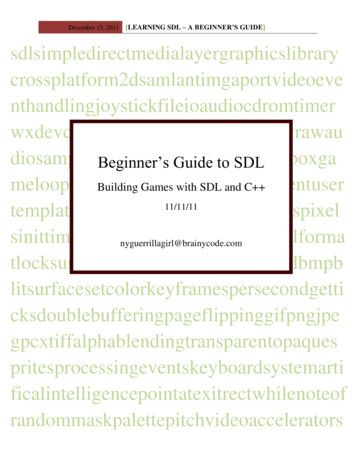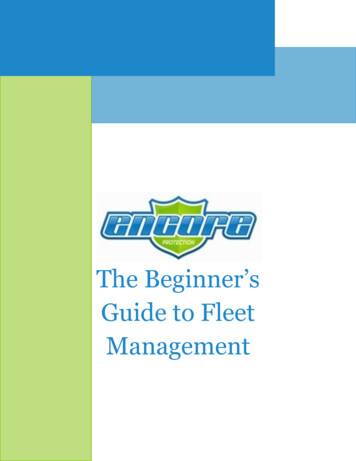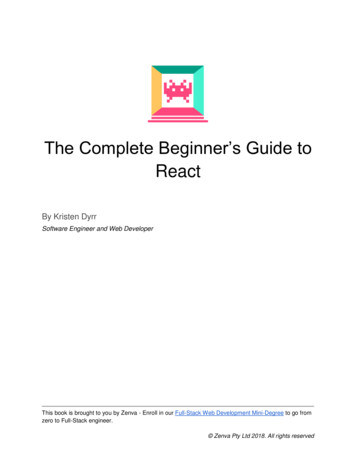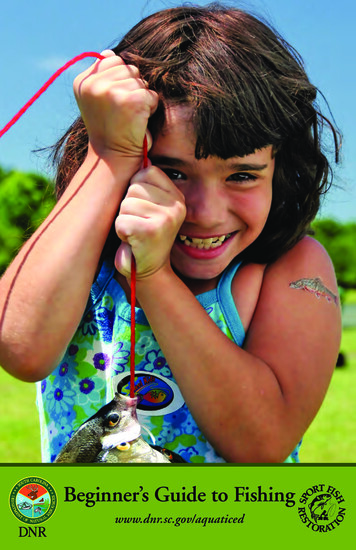
Transcription
Beginner’s Guide to Fishingwww.dnr.sc.gov/aquaticed
It is my hope that this guide will make yourjourney into the world of recreational angling (fishin’)uncomplicated, enjoyable and successful. As you beginthis journey, I encourage you to keep in mind thewords of the 15th century nun Dame Juliana Berner,“Piscator non solum piscatur.” Being a 15th centurynun, naturally Dame Juliana tended to write in Latin.This phrase roughly translates to “there is more tofishing than catching fish.” Dame Juliana knows whatshe’s talking about, as she’s believed to have penned theearliest known volume of sportfishing, the beginnersguide of its day, “ A Tretyse of Fysshyne with an Angle.”As you begin to apply the ideas and concepts in our beginners guide, you will startto develop new skills; you will get to exercise your patience; and, most importantly, youwill begin to share special experiences with your family and friends. In the early nineties,I can remember sitting in a canoe with my four-year-old daughter on the upper end ofLake Russell fishing for bream with cane poles and crickets. My daughter looked back atme from the front seat of the canoe and said, “Daddy, I sure do hate to kill these crickets,but we got to have bait.” Later, we spent hours together in the backyard perfecting hercast and talking about how to place the bait in just the right spot. We took those newskills to the pond. The first good cast, bait placed like a pro, and a “big bass” hit like afreight train. The first words out of her mouth were, “Daddy, what do I do now?” Allthose hours of practice and we left out the part about what to do when the fish show up.I hope this guide will insure that you have covered all the bases so you will be preparedwhen the fish show up.A limitless supply of wondrous treasures await you on the creeks, rivers, lakes andponds in our state. Use this guide as your key to unlock these treasures for yourself, yourfamily and your friends. The staff of the Department of Natural Resources will keepworking to insure you have places to fish and fish to catch. Your job is pick up a rod andstep outdoors to collect the treasures you will hold dear the rest of your life. Heck, if itwasn’t for fishin’ my daughter would never have been able to answer the bonus questionin her class at college, “How many links are in a can of Vienna Sausage?” There is moreto fishing than catching fish, and the memories are always bigger than the fish.Ross L. SelfChief, Freshwater Fisheries
Welcome to FishingLearning to fish can be as simple as tying your shoe. You mayfind yourself sitting on the bank of a river or pond using a cane poleand a can of worms, or using a fully-rigged boat with state-of-the-artequipment. Either way, with some basic knowledge and minimumskill, a beginning angler can embark on a lifetime of fun, relaxationand camaraderie with other anglers.Discussed in the next few pages are several styles of fishing, typesof rods, reels, knots, baits, lures, freshwater fish and aquatic habitats.You’ll find tips to improve your skills and prepare you for a fun,exciting and successful fishing trip. You’ll also learn ways to protectyour aquatic resources.And don’t forget, fishing isn’t just about catching fish! Asexperienced anglers will tell you, fishing is one of the best waysfamilies and friends can relax together as they enjoy being outdoorsand learning new skills.1
2
Table of ContentsAngler Ethics.4Safety.5Rules and Regulations FAQs.6Catch & Release Fishing.8Equipment Overview.9Tackle.10Rods .12Reels.14Casting.16Fishing Knots.23Tackle Box Checklist.26Rigging.27Live Baits.28Artificial Lures.29Nibbles & Bites.32Drag.32Setting the Hook.33Fish Anatomy.34How to Handle Your Catch.36How to Clean Your Catch.39Invasive Species.41Identifying Good Fishing Spots (Habitat).45Bream Fishing .46Black Bass Fishing.52Catfish Fishing.57Crappie Fishing.62Trout Fishing.66Aquatic Education Programs .713
Angler EthicsWhat are ethics? Rules and values that change your behavior, causing you to do theright thing.To determine if something is ethical, ask yourself three questions: Is it legal? Would it still be ok if everyone was doing it? Would it make you or people who know you proud?Ethical Anglers: Are considerate of one another, respecting other anglers’ space andbeing quiet so as to not disturb others. Always leave their fishing area cleaner than when they arrived so asto protect the resource. Abide by all rules and regulations. Obey all fishing regulations and reportviolators by calling 1-800-922-5431. Respect the resource. Keep only those fish that are injured or thoseyou intend to eat. Respect the rights of landowners. Get permission to fish on theirproperty first. Respect other anglers’territory or space. Treat themthe way you would like to betreated. Pass it on. Teach a child or afriend to fish. Support fisheries researchand habitat protectionthrough your South CarolinaDepartment of NaturalResources (SCDNR).4Photo courtsey of Take Me Fishing
Safety Keep at least one rod’s length between you and the next anglerbefore, during and after you cast. Always look behind you and to the side before casting to preventhooking power lines, trees or a person. Wear sunglasses, sunscreen, bug spray and other protection fromthe natural elements. Always be aware of your surroundings and be on the alert for antmounds and snakes. Avoid thick grassy areas where you can’t seeyour feet. Be very careful around water and make sure you have a fishingbuddy with you. If fishing from a boat, always wear a life jacket orPFD (personal flotation device).SC Reel Kids fishing safely with their PFDs5
Regulations FAQsWhy do we have Regulations? People! Along with natural pressuressuch as predators and competition for food and space, fish have to worryabout pressures we put on them. Those pressures include pollution, in theforms of litter and runoff, which damages water quality; loss of adequatehabitat due to changes in the landscape, such as urban developmentand farm practices; and overfishing, which comes from the unnecessaryharvest of too many fish or from harvesting fish that are too small andhaven’t had the opportunity to reproduce. SCDNR’s role is to protectand manage the resource through science and provide suggestions to thelegislature on necessary laws. The South Carolina General Assembly thenvotes to make the bills law and SCDNR law enforcement officers enforcethese laws. Some of the common management practices include daily bagor creel limits on the amount of fish an angler can catch and possess ina day, slot or size limits on fish to allow fish to reach sexual maturity andreproduce and restrictions on what type of gear can be used to harvest orcatch certain fish—game versus non-game.Frequently Asked Questions about Fishing RegulationsWhere do I find fish and wildlife regulations for the state of SouthCarolina? Regulations are available at everylicense vendor in the state. They arealso found on the website at www.dnr.sc.gov/regulations.At what age, do I need a fishing license? When you turn 16, you must have afishing license in order to fish legallyin public waters.6
Do I need a fishing license to fish from my private property? Yes, you will need a license to fish in public waters (such as lakesor rivers) even if you’re on private land. You don’t need a licenseto fish on private property in a private pond unless you are fishingin a commercial pay pond. You don’t need a license to fish in acommercial pay pond when the pond is permitted by DNR.Where do I go to buy alicense? You can visit any ofthe 500 license agentsthroughout the stateat the nearest localbait and tackle store;the SCDNR office inCharleston, Clemson,Columbia and Florencebetween8:30 a.m.-5:00 p.m.Monday throughFriday; or call 1-866714-3611 (7 days aweek 24 hours a day),or visit the web at www.dnr.sc.gov/purchase.When I buy a license,how is that money used? Every fishing licensepurchase helps tosupport fisheriesresearch, habitatenhancement and management projects.For questions regarding your license purchase, please call 803-734-3833.7
Practice Catch & Release FishingPractice Catch & Release FishingCurrently, many fish species of popular game fish have legallymandated size and catch limits, requiring anglers to release undersizedand over the limit fish. Many anglers voluntarily release their fish. If thesefish are not released properly, their chance of survival is reduced.Whether anglers choose to release fish or are required to do so by law,all released fish should be handled carefully to give the fish the best chancefor survival.When practicing catch and release fishing, you should do the following: Use barbless or circle hooks and needlenose pliers or forceps toreduce injury and handling time of the fish. Land the fish as quickly as possible to minimize the fish’s fightingtime. Use wet hands when handling a fish and minimize the time out ofwater to 20 to 30 seconds. Never hold a fish by the gills. When returning a fish to the water, point the fish into the currentor cradle it in your hands loosely under the water until the fishswims away on its own. If a fish is landed and the hook has been swallowed, cut the line asfar down in the fish’s mouth as possible. Do NOT pull the hookout!Catch & KeepMost of the game fishspecies are excellent fare for thefrying pan or grill. If fishingto keep, make sure you followall fishing regulations withregards to size and catch limits.Keep only fish you will use andrelease the rest. Plan ahead andbring a proper storage container to put the fish on ice or in water. Get fishcleaned as soon as possible and enjoy! Bon appetite!8
Equipment OverviewBasic Fishing Tackle or Terminal TackleHooksHooks come in a variety of sizes and shapes. Size 1/0 (called oneaught) is big to size 12, which is small. For hooks size 32 to size 1, thelarger the number, the smaller the hook. For hook sizes from 1/0 to19/0, the larger the number, the larger the hook size. Popular hookstyles are: treble, Kirby, octopus, wide gap, O’Shaughness, baitholder,circle and weedless.To determine what hook size to use, picture the species you’d liketo catch and look at its mouth and what they like to eat. Hook anatomy– Point: The sharp end of the hook that punctures the fish’s mouth;there are many different point types such as spear, hollow or rolled in.– Barb: An extension of the point that projects backwards to keepthe fish on your hook.– Eye: Just like an eye of a needle, the eye of the hook is the loopat the top used to connect the hook to the line; there are manyEyetypes of eyes and they can be positioned in many ways onthe shank (up-turned, down-turned, straight, ringedor lopped).Point– Bend & Shank: The portion of the hook thatShankconnects the point to the eye; the hook shankBarbcan be straight or have curves, kinks, bends andoffsets which allow for easier setting of the hook,better fly imitation or bait holding.Bend9
Equipment Overview Monofilament Line– Like the hooks,monofilamentline comes in avariety of weightsfor differentspecies.– Monofilamentline is measuredin “poundtest,” meaningthe amount ofweight required to break the line. 10 pound test line is strongerand thicker than 6 pound test line; so the higher the pound test,the stronger the line.– When choosing the right pound test, it is always best to match theline to the capabilities or size of your rod and reel and to take intoaccount the lures/bait you’re using and the species you want tocatch.– Always discard properly or recycle monofilament line as it cancause harm to wildlife. Fluorocarbon Fishing Line– Other alternatives to standard nylon monofilament lines have beenintroduced made of copolymers or fluorocarbon, or a combinationof the two materials. Fluorocarbon fishing line is valued for itsrefractive index, which is similar to that of water, making it lessvisible to fish. Fluorocarbon is also a more dense material, andtherefore, is not nearly as buoyant as monofilament. Braided Fishing Lines– There are also braided fishing lines, cofilament and thermallyfused lines, also known as ‘superlines’ for their small diameter,lack of stretch, and great strength relative to standard nylonmonofilament lines.10
Sinkers– Sinkers come in a varietyof weights (measured inounces) and shapes.– They allow you t
habitat due to changes in the landscape, such as urban development and farm practices; and overfishing, which comes from the unnecessary harvest of too many fish or from harvesting fish that are too small and haven’t had the opportunity to reproduce. SCDNR’s role is to protect and manage the resource through science and provide suggestions to the legislature on necessary laws. The South .
